Wonderful Whitby
Runswick Bay
Runswick Bay is a very unusual picturesque fishing village, situated 9 miles northwest of Whitby. It's beautiful red-roofed cottages cling to the ever decreasing cliffside. Runswick Bay is accessed by a very steep road leading off from the A174, new visitors will be surprised at the beautiful vista greeting them! There are two car parks, one at the bank top and the other at the bottom near brightly coloured cobles. The village has a crescent shaped beach, stretching around the bay which is popular with holiday-makers
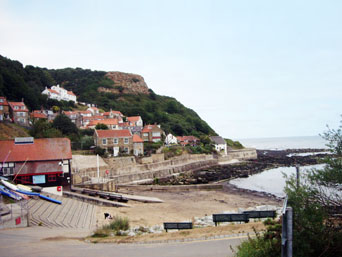
The Village of Runswick Bay
Due to Runswick Bay's situation, the sea has been both friend and foe to the communities here. There is evidence that Runswick Bay was inhabited before the Roman times, but in centuries past a lot of the original village has disappeared. In 1682 a landslide caused all the cottages bar one, to fall into the sea. Fortunately there was no loss of life. In 1858 a huge storm washed away a small ironworks of 2 furnaces, an engine house and chimney. Cracks have been appearing in the cottages over years and in 1970 a sea wall defence was put in place to try to protect the remaining cottages.
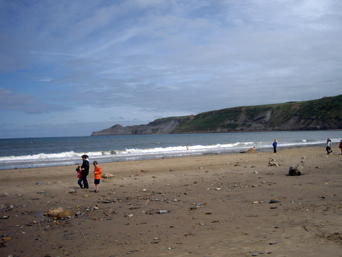
Runswick Bay Beach
There is one thatched cottage left, the old coastguard's house, which is the only remaining one on the North Yorkshire Coast. Smuggling was rife on this coastline with many coves and inlets, with which to land illegal goods. Most of the villages along this section of coast were involved. Shipwrecks also provided the locals with ‘extras’! Runswick Bay was a safe haven for fishing boats for over 600 years. The population of the village was mainly involved in the fishing industry with all members of the family, women and children, playing their part. In the 1840s, there were 20 cobles.
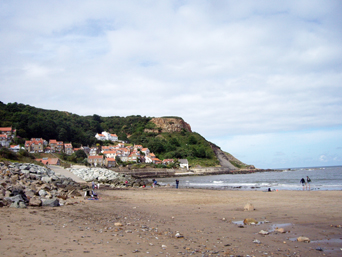
Runswick Bay Beach
Every August the men went to join the herring fleet, bringing back some of their catch for themselves and their families, and storing them in the wooden herring houses, that stood on site of the car park. In later years many men folk worked in the alum quarries and ironstone mines. With the advent of the railway many new houses were built at the top of the cliff, and eventually the fishing industry declined and many of the villagers moved away. By the 1940's, the shops had closed and Runswick Bay became more of a holiday village with only a few local inhabitants.
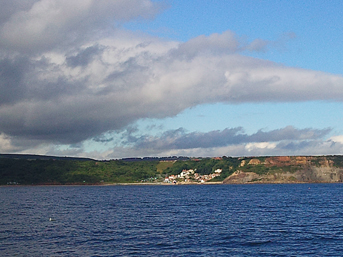
Runswick Bay from the Sea
The first lifeboat ‘The Sheffield’ arrived here in 1866 and was manned by a crew that was able to row for miles in rough seas. In 1901 when a sudden storm erupted and many men of the village were out at sea, the women hauled the lifeboat and launched it themselves the save the men folk. The last RNLI lifeboat was launched on the 1st July 1978 after 112 years service. In 1982 the Runswick Bay Boat Rescue was formed, and is an independent registered charity funded by donations and fundraising by the community. It is an inshore craft and works in cooperation with the RNLI and HM Coastguard.
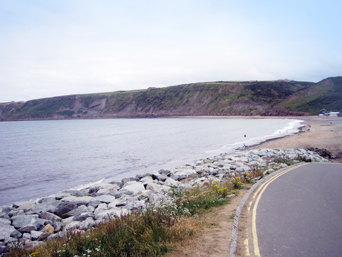
Runswick Bay Beach
The village itself has steep steps and is not easily accessible for those with walking difficulties. There is the Institute, built in 1870 which is the focal point for the village and the old Methodist Chapel built by the womenfolk of the village in 1829 (now a private dwelling), behind which is a spring where the women collected the water (mains water not being supplied until the 1950s).
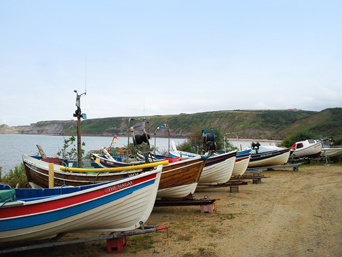
Boats at Runswick Bay
There are three public houses in Runswick Bay. The Royal Hotel in the lower area of the Bay, and the Runswick Bay Hotel and the Cliffmount Hotel at the top of the cliff area leading down. The two latter Hotels offer accommodation. There is bed and breakfast accommodation and self-catering accommodation as well as a caravan and camping site.
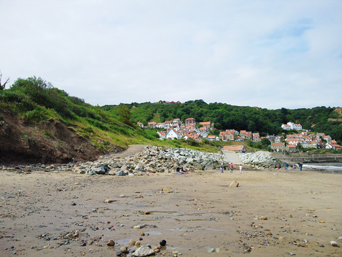
Runswick Bay
Along the beach can be found the Runswick Bay Beach and Sailing Club, which is open on Sundays from April to October and offers many facilities to its members. The beach is a delight for fossil hunters (ammonites being one of the specialities around here). Further along the beach are the remains of a pillbox and anti-tank cubes, built during the Second World War. There are public conveniences near the car park on the upper bank top. Runswick Bay is on the Cleveland Way National Trail.
